Wednesday 29 December 2010
Joshoncomics Review of 2010
Wednesday 22 December 2010
How Did Writer's Tackle the Spider-Marriage?
 One of the major bones of contention among Spider-Man fandom in recent years has been the character's marriage - or lack thereof. Joe Quesada's hugely controversial decision to terminate Peter and Mary-Janes wedding in the widely panned One More Day storyline has literally split the webslinger's fanbase through the middle. Whether you loved it, hated it or are somewhere inbetween it is a definite fact that several writers disliked the marriage, and found it difficult to write stories with a married Spider-Man. However - arguably just as many writers thoroughly enjoyed the challenge of writing a married Spider-Man and thrived under the constraints that the marriage provided. In this article I intend to look at a few of the more notable writers who dealt with a married Spider-Man, looking at who was successful and who was...less than successful.
One of the major bones of contention among Spider-Man fandom in recent years has been the character's marriage - or lack thereof. Joe Quesada's hugely controversial decision to terminate Peter and Mary-Janes wedding in the widely panned One More Day storyline has literally split the webslinger's fanbase through the middle. Whether you loved it, hated it or are somewhere inbetween it is a definite fact that several writers disliked the marriage, and found it difficult to write stories with a married Spider-Man. However - arguably just as many writers thoroughly enjoyed the challenge of writing a married Spider-Man and thrived under the constraints that the marriage provided. In this article I intend to look at a few of the more notable writers who dealt with a married Spider-Man, looking at who was successful and who was...less than successful.Saturday 18 December 2010
Spider-Girl # 1 Review

Spider-Girl #1 by Tobin / Henry
Monday 13 December 2010
Tpb Review: Batman - Gothic
 Batman: Gothic, collecting Legends of the Dark Knight #6-10 by Morrison / Janson
Batman: Gothic, collecting Legends of the Dark Knight #6-10 by Morrison / JansonWednesday 8 December 2010
Are Digital Comics the Future? Part Two
Wednesday 24 November 2010
Are Digital Comics the Future? Part One
Thursday 14 October 2010
Retro Review: Thunderbolts #18

Thunderbolts (volume 1) #18 by Busiek / Bagley
Monday 2 August 2010
Tpb Review: Scott Pilgrim - Precious Little Life

Wednesday 16 June 2010
Wolverine and the X-Men: Episode One Review
 Despite being a fan of Marvel Animation, Wolverine and the X-Men was never a series that I had much interest in. Perhaps this is due to my recent lack of recent interest in the X-Men franchise, perhaps it's more to do with Wolverine's prominent placement in the series title. Either way, up until earlier this evening I had made very little effort to watch the show. This all changed when I noticed a DVD containing the first six episodes on sale for £2 (for my American readers, I'm not sure how much this is in $ - probably not a lot). At such a knockdown price I could hardly turn it down and settled down about half an hour ago to watch the first episode.
Despite being a fan of Marvel Animation, Wolverine and the X-Men was never a series that I had much interest in. Perhaps this is due to my recent lack of recent interest in the X-Men franchise, perhaps it's more to do with Wolverine's prominent placement in the series title. Either way, up until earlier this evening I had made very little effort to watch the show. This all changed when I noticed a DVD containing the first six episodes on sale for £2 (for my American readers, I'm not sure how much this is in $ - probably not a lot). At such a knockdown price I could hardly turn it down and settled down about half an hour ago to watch the first episode.Saturday 29 May 2010
Retro Review: Spider-Man: Redemption
 Spider-Man: Redemption #1-4 by Dematteis / Zeck
Spider-Man: Redemption #1-4 by Dematteis / ZeckTuesday 18 May 2010
Review: Sentry - Fallen Sun
 Sentry: Fallen Sun by Jenkins / Raney
Sentry: Fallen Sun by Jenkins / RaneySunday 16 May 2010
News...Yes that's right, news!
Friday 14 May 2010
Not-Quite-Retro Review: Daredevil - Golden Age
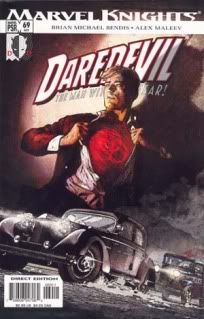 Daredevil (volume 2) #66-70 by Bendis / Maleev
Daredevil (volume 2) #66-70 by Bendis / MaleevWednesday 12 May 2010
Dark Reign: My Verdict

Dark Reign was a great idea. Letting the villains 'win' is an often underused plot, particularly in the Marvel Universe. While it has been done before (Kurt Busieks' excellent Kang Dynasty story arc among others) this is the first time it has been truly attempted on a company wide scale, with the vast majority of Marvel's books tying into the central story. Did it work? In my opinion, not really...
The story started off brilliantly. Norman Osborn was a great choice of villain and it seemed fresh and interesting to see him in a position of such great power. The cabal were also great fun. I wasn't around for the 90's Acts of Vengeance crossover so I loved seeing some of Marvel's most well known villains (and the Hood) interacting with each other. The group had a great dynamic with the charismatic duo of Doom and Loki often upstaging Osborn.
The tie-ins were generally excellent as well. The Thunderbolts in particular worked very well in their new niche as Osborn's black ops squad. The Dark Avengers were also great as a grittier, modern day reworking of the original Thunderbolts concept and for me marks a high point in Bendis' modern day writings. It was cool seeing a total reversal in Tony Stark's fortunes in Matt Fraction's Invincible Iron Man as well. And as I detailed in an earlier post Dan Slott's Mighty Avengers served as an excellent tonic to the moodiness of the rest of the Marvel Universe, while still tying loosely into Dark Reign.
So where did it go wrong? For me, Dark Reign was almost doomed from the start. Even in the early months as Osborn's fragile sanity began to collapse it became clear that it was a case of when, not if he would be deposed. Osborn was ultimately an unconvincing figurehead for the cabal. There were some hints that Doom would take over but they came to nothing and he now appears to have been shunted off into his own corner of the Marvel Universe in Doomwar. The inevitability of Osborn's collapse robbed the story of much needed feelings of hopeless and dread.
The tie-ins gradually decreased in quality as well. Thunderbolts seemed for the latter half of Dark Reign to be in a constant struggle to validate its existence, with even fan favourite writer Jeff Parker unable to give the title a point. Mighty Avengers collapsed as well, Slott's bizarre insistence on 'redeeming Hank Pym reaching ridiculous levels by the books increasingly silly conclusion. Dark Avengers was a very well written core book but suffered from Bendis' lamentable insistence that every team that he writes needs to be dismantled within a handful of story-arcs. The Dark Avengers seemed to have barely got started before they had been jettisoned (a shame too - it's probably been my favourite Marvel book for the duration of Dark Reign).
And Siege. Ah...Siege. Hyped as a story seven years in the making Siege has been acclaimed as the best 'event book' since House of M started the trend. I agree, it's been a solid series, but as a conclusion to a status quo as promising as Dark Reign was it seems little more than a predictable four issue long slugfest. I won't even go into the effect it's had on Thor, one of my favourite books. Kieron Gillon has done an admirable job under difficult circumstances but Siege has sadly made the title's plot seem irrelevant.
I would like to reiterate, this was not a post intended to bash Marvel. I actually thought they got a lot right during Dark Reign and it let to some enjoyable stories . For me though, it fell some way short of being classed as a classic era of Marvel Comics. If you enjoyed it more than I did...I'm happy for you, and I would love to hear why, leave a comment!
Thursday 22 April 2010
Retro Review: Spider-Man: Torment

Torment has little plot for a five issue storyline. Basically, Spider-Man heads out to investigate a serial killer that he suspects to be old foe the Lizard. After finding the Lizard Spideyengages himself in one of the more brutal fights in the characters history, being drugged by a voodoo priestess along the way.
This stories greatest strength, by a long shot is its presentation. The issues have a very dark, almost gothic style, with the panels laid out in an abstract way never before seen in a Spider-Man book. The art, while clearly not being to everyones taste is spectacular, dynamic and vibrantly coloured. While his anatomy is not always spot on Mcfarlane draws Spider-Man very well, retaining the creepiness brought to the character by Steve Ditko while adding more modern sensibilities. His redesign of the Lizard is inspired as well and is as terrifying as any comic book villain has ever looked. However, McFarlane's storytelling is fairly weak. while individually his panels look great it is often unclear what is actually happening.
It is sadly indicative of McFarlane's priorities with this story that the first thing I discussed was its presentation. As I said before, Torment looks great but there is never that much going on below the surface. It definitely shows that this was McFarlane's first assignment as a writer, as he makes some amateurish decisions, most notoriously the ludicariously pretensious narrative captions that run throughout the story. McFarlane seems to be going for a 'Stan Lee for the 90's vibe' but sadly falls flat on his face. Torment is also very decompressed. While this has become quite the trend in recent years this does not make it excusable. Torment was clearly influenced by JM Dematteis' classic six part storyline 'Kraven's Last Hunt', but that story actually had the substance to justify its extended length, something that Torment is lacking.
McFarlane's characterisation of Peter Parker, Mary-Jane and their relationship is actually one of Torment's strengths in my opinion. McFarlane has a good handle idea of Peter Parker's 'voice', and while many have criticised the Mary-Jane focused sections of the story I enjoyed them and felt that they gave an interesting insight into MJ's character development since settling down with Peter and how events echoing Kraven's Last Hunt have become all too commonplace for her.
Overall Torment is a solid story, very well presented and perhaps only hampered by McFarlane's inexperience as a writer and the lofty expectations placed upon it
C+
Saturday 17 April 2010
Tpb Review: Madrox - Multiple Choice

Madrox #1-5 by David / Raimondi
Sunday 28 March 2010
Spider-Man's Top Ten Villains: Best of the Rest
Carnage

First Appearance: Amazing Spider-Man #361
Recommended Reading: Amazing Spider-Man #361-363
The Scorpion

First Appearance: Amazing Spider-Man #20
Recommended Reading: Spectacular Spider-Man #215-216
The Vulture

First Appearance: Amazing Spider-Man #2
Recommended Reading: Friendly Neighbourhood Spider-Man #14-16.
Electro

First Appearance: Amazing Spider-Man #9
Recommended Reading: Spider-Man #38-40
Morlun:

First Appearance: Amazing Spider-Man #471
Recommended Reading: Amazing Spider-Man #471-476
The Lizard

First Appearance: Amazing Spider-Man #6
Recommended Reading: Spectacular Spider-Man (volume 2) #11-13
Sunday 21 March 2010
Spider-Man's Top Ten Villains: Part Two
5. The Sandman

Perhaps a surprising choice for inclusion in my top five, I consider The Sandman to be one of Spider-Man's most underrated foes. Despite being one of the first villains he ever faced, as with many the bulk of his earlier foes Sandman's characterisation has occurred in more recent years, with the villain enjoying a ten year spell of reformation during which he even appeared as an Avenger! Since then he has inexplicibly returned to the side of villainy, but is still a highly morally ambiguous character with an intriguing moral compass. And of course I can't fail to mention his inspired design. Perhaps one of Ditko's more realistic costumes, the Sandman's striped shirt has survived it's fair share of attempted revamps to become one of the most iconic designs among Spidey's enemies.
First Appearance: Amazing Spider-Man #4
Recommended Reading: Friendly Neighbourhood Spider-Man Annual #1, Amazing Spider-Man #302.
4. Venom (Eddie Brock)

Since his introduction in the classic ASM #300 Venom's popularity has exploded, and he is arguably the only modern Spider-Man foe to earn a place on the A-List of villainy. Venom is a classic 'mirror image' villain, of which Spider-Man always lacked in his early days, and his relentless style and almost frightening design was a start contrast with some of the more outdated (but still cool) Ditko villains. Perhaps would have placed higher but the character has stagnated in recent years, from the ill advised move of turning him into an anti-hero to the pointless one of replacing Eddie Brock with Mac Gargan aka the Scorpion, turning two solid villains into one average one.
Recommended Reading: Amazing Spider-Man #300
3. The Hobgoblin (Roderick Kingsley)

The Hobgoblin was originally creating to fill the hole in Spider-Man's rogues gallery left by the absence of a Green Goblin, yet has become an inspired villain in his own right. A superb modernisation of the Green Goblin's costume coupled with an intriguing mystery (albeit one that perhaps went on too long) made Kingsley one of Spider-Man's most popular foes in the 1980s. Part of his appeal as a villain also lies in his status as perhaps the one foe that Spider-Man has never truly defeated...Kingsley is currently enjoying a relaxing retirement on an unnamed Caribbean island. Will he ever return? Most Spider-fans would love to see Kingsley again, but either way he will surely go down as one of Spider-Man's most persistent, intelligent adversarys of all time.
First Appearance: Spectacular Spider-Man #43 (As Kingsley) Amazing Spider-Man #238 (As Hobgoblin)
Recommended Reading: Amazing Spider-Man #238-239, 249-251.
2. Doctor Octopus

This man had to be in the top two. From his very earliest appearances 'Doc Ock' has tormented Spider-Man time after time, from handing the teenager a humiliating defeat in his first appearance to causing him to be partly responsible for the death of Gwen Stacey's father Captain Stacy, a man who had become something of a father figure to Peter. Doctor Octopus conjures up images of the sort of man Peter Parker may have become had he not had the guiding figure of his uncle Ben and aunt May in his life, a man twisted by his love of science and the lack of affection of those around him. Recently revealed to be terminally ill in Amazing Spider-Man #600, I sincerely doubt we have seen the last of Doctor Otto Octavius.
First Appearance: Amazing Spider-Man #3
1. The Green Goblin (Norman/Harry Osborn)

I would like to say that I had a tough time choosing the number one spot on this list, but in reality this couldn't be further from the truth. The Green Goblin is Spider-Man's deadliest foe, there is no question about that. Whether we are talking about Norman Osborn or his son Harry, there is no other villain which such a long lasting legacy of misery over the lives of both Peter Parker and Spider-Man. Heralded by Norman becoming the first villain to learn that Peter Parker and Spider-Man are one and the same and cemented by Norman's death driving a wedge between former best friends Peter Parker and Harry Osborn, the conflict between the Green Goblin and Spider-Man is nothing if not personal. From killing his first love, Gwen Stacy, to faking the return of his parents, to engineering the Clone Saga there is little that the father and son duo haven't done to terrorise Spidey. And with Harry recently returned to life it is a sure thing that you will see more diabolical plots from them in the future.
Wednesday 13 January 2010
The Spider-Man Movie Reboot: My Thoughts

Firstly I should make it clear that I have no problem whatsoever with the Raimi films. The first two are great, the third less so, but they are all enjoyable enough. The cast is pretty much perfect as it is. Maguire isn't perfect, he still has yet to nail the wisecracking elements of the character and struggled with some of the more emotional scenes but I think apart from that he was pretty much perfect. However, he is possibly getting a little too old for the role so I'm not too dissapointed with the idea of a recast. A lot of people had major problems with Kirsten Dunst as Mary-Jane, but I can't say I agree with them. Dunst is a good actress and deserves little of the abuse that she gets for her portrayal of MJ, the vast majority of the problems with the character come from her characterisation, and overuse as a damsel in distress. There is little that any actress could do to overcome that. The villains were all perfectly cast in my opinion (Yes even Venom and Sandman), as were most members of the supporting cast. I would have no problems whatsover with the likes of JK Simmons and Rosemary Harris returning as Jonah Jameson and Aunt May respectively.
In terms of story, I can't see the reboot dealing with Spidey's origin. For starters, it is one of the most iconic origin stories in comic book history. Beyond a brief recap the vast majority of the audience will not need to see it again, particularly as the original Spider-Man was released less than a decade ago. Raimi as far as I'm concerned also told as good an adaption of the origin as I have ever seen, and I'm unsure of how it could be improved upon, something that is only going to harm the film.
It has been confirmed that the Reboot will deal with Peter Parker's time at High School, something that gets a big thumbs up from me. The High School setting was notably underused in Raimi's trilogy, and a Reboot will give potential directors a chance to explore it, hopefully giving more screentime and development to the likes of Betty Brant, Flash Thompson and Liz Allen, who comprised the bulk of the Webhead's supporting cast in his early years. In fact, I would not be totally adverse to leaving out Mary Jane and Gwen Stacy entirely, instead using Liz Allen and Betty Brant as love interests. Mary Jane was originally a mystery character in the comics, who was seen many times in silhouette or with her face obscured before finally making an appearance. This is an approach that I think a Reboot could easily take. In terms of supporting cast, I would be fine with limiting it to those that were actually around when Peter was at High School in the comics, leaving out Harry Osborn for one. It is often forgotten that the Peter Parker of these stories was a loner who had very few, if any friends. It could be interesting to see this sort of take on the character on screen, perhaps eventually introducing Betty and Liz as friends or love interests as he grows in confidence. However, Harry, Gwen and MJ are integral parts of the Spider-Man mythos and it would take a very brave man to leave the trio out entirely.
Villainwise I would be dissapointed to see any villains that have already appeared, with the possible exception of Dr. Octopus. While I loved the character in Spider-Man 2, it was a much more sympathetic portrayal than in the comics, with the good doctor actually befriending Peter shortly before his accident, and then saving the day at the films climax. I think it would be interesting to see him as more of a straight villain, perhaps an adaption of the critically acclaimed Master Planner storyline? However there are still a number of classic villains that haven't been seen on film, and the likes of Electro, the Chameleon and Mysterio would all be solid choices. Either way I think that Norman Osborn needs to play a part in the movie, perhaps as a man in the shadows behind the films main villain? This was an approach taken by both Spider-Man: The Animated Series and the Spectacular Spider-Man show, very successfully in both cases!
Most importantly, I want to be able to judge the new film on its own merits, and not to have it compared to the Raimi trilogy. Yes it was generally good, but I would love the relaunch to go in a completely different, exciting direction, showing us aspects of Spider-Man's life never before captured on the silver screen.
NEXT: FINALLY - My rundown of Spider-Man's top five foes
Monday 11 January 2010
Spider-Man's Top Ten Villains - Part One
10. Kraven the Hunter

Initially Kraven was probably one of the least impressive of the Lee/Ditko created villains. Overly camp with somewhat lame powers, he was never a credible threat for the webhead in his early appearances. All of this changed with JM Dematteis' groundbreaking storyline 'Kraven's Last Hunt', a deep, dramatic storyline that delved into Kraven's motivations and just nudges him into the top 10. Just try to ignore his increasingly lame offspring that keep getting introduced.
First Appearance: Amazing Spider-Man #15
Recommended Reading: Kraven's Last Hunt (Web of Spider-Man #31-32,Amazing Spider-Man#293-294, Spectacular Spider-Man #131-132)
9. The Kingpin
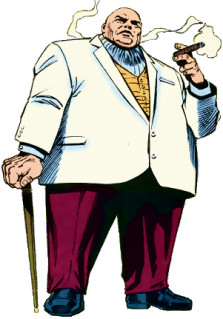
Although he was introduced in Amazing Spider-Man, Kingpin has since evolved into a more persistant adversary for Daredevil after his successful use in Frank Miller's run. Nonetheless his initial battles with Spider-Man are among the best in the characters history. Before his introduction Spider-Man had mainly faced off against colourful costumed villains (with a few exceptions), The besuited Kingpin's debut was a welcome contrast to this, and heralded many future gang based storylines.
First Appearance: Amazing Spider-Man #50
Recommended Reading: Amazing Spider-Man #50-52
8. The Chameleon
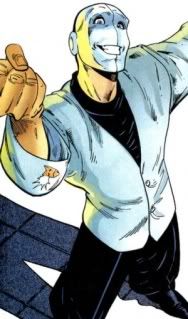
The Chameleon was the first ever villain to battle Spider-Man, and despite being physically inferior to many of Spider-Man's other enemies he has been a consistent danger to the wallcrawler since. Favouring carefully laid out schemes rather than the knock-out brawls of other villains, among his devious plans have been kidnapping and replacing Jonah Jameson and convincing Peter Parker that his parents were alive through the use of androids. The master of disguise has recently been revamped by writer Fred Van Lente in the 'Red Headed Stranger' arc of Amazing Spider-Man.
First Appearance: Amazing Spider-Man #1
Recommended Reading: Webspinners Tales of Spider-Man #10-12
7. Kaine
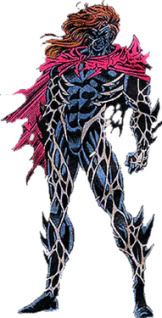
On first glance a typical 90's 'mystery villain', Kaine is actually able to boast more depth than the vast majority of Spidey's rogues gallery. A failed, twisted clone of Peter Parker has also struck me as being a fantastic concept for a villain, a concept which has arguably never reached it's full potential (Beyond JM Demetteis' excellent Mini-series The Lost Years). Nonetheless, Kaine has recently been reintroduced to the Spider-titles, and appears consistently in Tom Defalco's Clone Saga loveletter Spider-Girl. He remains a huge threat to the Web-Slinger.
First Appearance: Web of Spider-Man #119
Recommended Reading: Spider-Man: The Lost Years #1-3
6. Mysterio
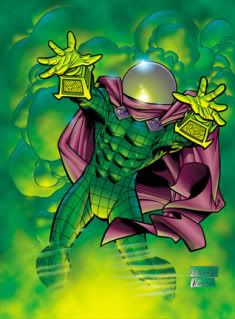
Blessed with one of Steve Ditko's most gloriously goofy costumes (and that's saying something), the master of illusion has become one of Spidey's most persistent antagonists, even joining every iteration of the Sinister Six! While often being regarded as a joke, partly due to his rather silly name and appearance, when taken seriously by writers Mysterio has proven to be one of the more colourful, wacky member of Spidey's rogues gallery, while more recently being given some much needed emotional depth.
First Appearance: Amazing Spider-Man #13
Recommended Reading: Amazing Spider-Man #198-199, Webspinners Tales of Spider-Man #1-3.
That's all for now folks, tune in next time for my top five Spider-Man villains of all time!
